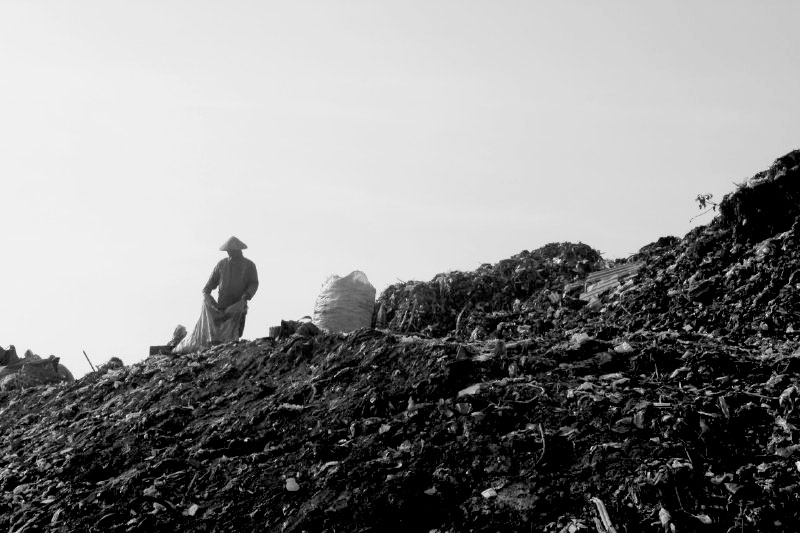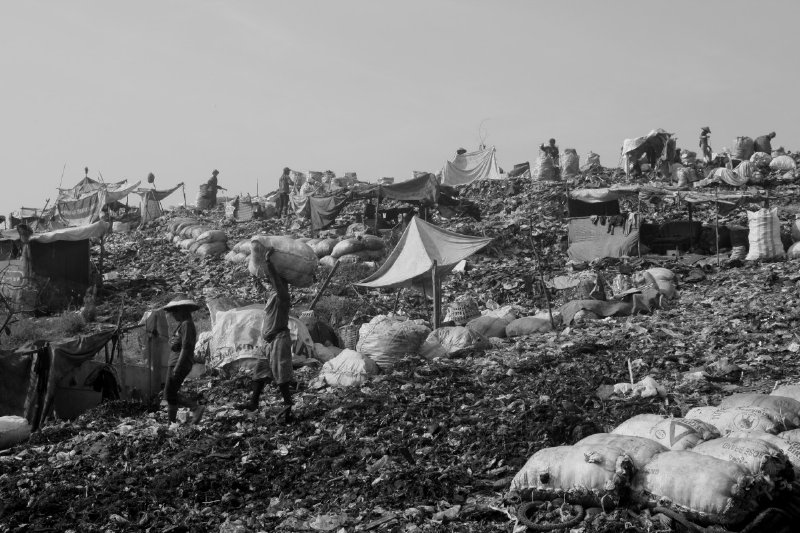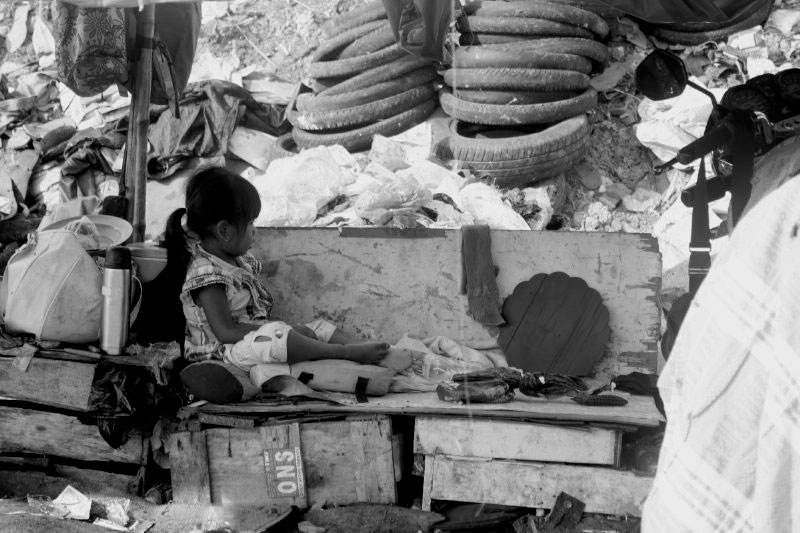
The place remains the same, filled with a nauseating stink, putting you on the unenviable brink of sneezing and throwing up. It fouls up your throat, lungs and guts. Mountains of waste lay quietly in an area of almost 27 hectares between shrimp farms, peasant salt farms, and the imposing development of Bung Tomo sport stadium, which is now in its final stage. They’re like miniature valleys, with clusters of more than a thousand humans in caping (conical woven hat). Like flies buzzing around rotting food.
“It’s so disgusting and embarrassing,” the developer of the stadium complained.
“The smells are so foul and unhealthy,” said residents of Tambakrejo and Tambakdono, Pakal, Benowo, many of whom have protested the existence of the most recent landfill in Surabaya. Imagine, 1200 tons of waste is disposed here every day, the waste of more than three million people.
“Our home, it’s like the accumulated foul stench of all people of Surabaya,” said one resident.
Ironically, these mountains of waste – which are enough to make your stomach churn just by looking at them – are the source of sustenance for around 1200 pemulung (waste pickers). They come from the surrounding areas, including: Banyuwangi, Jember, Probolinggo, Mojokerto, and Madura. Waste pickers choose to rummage through the garbage for a wage of Rp.60,000 per day, which they attain just by capitalizing on the ability to withstand the immense stink and disgust. When jobs are scarce and unreachable, the pay is tempting enough. Simple, yes, but not something that anyone can act upon.

More than 1200 tonnes of waste disposed here, every day, sustaining more than 1200 waste pickers
Around 1996, I visited Sukolilo landfill, which is a pre-Benowo dump site, with a friend. During my visit, my friend and I tried talking to a couple of siblings, one of whom was in primary school year two, the other in year four. They were collecting soap packages and boxes under the heat of the sun. Having recently returned from school, they told us that they collect the wrappers and the boxes in the piled of waste to pay for school fees and some pocket money. They were very excited when we bought them some iced tea and snacks from a warung next to the mountains of garbage.
At the end of 2003, I visited the new Benowo landfill. It was still dry. There were no buildings nearby, just huts containing a few bicycles of the waste pickers. I freely entered the landfill, talking to two child waste pickers, Jumaidi and his younger brother Ali. We were joking, laughing, and taking photo until the time to break the fast arrived (it was the fasting month then).
“Drop by again sometime, take photos of us,” the boys told me. They also said they could compile 200 kg plastic bags per month. Their net income then could be up to Rp.600,000-700,000 per month. Their lives were far more independent than more than 40 million unemployed in this country.
On Saturday morning, June 11, 2011, I visited Benowo landfill again. A friend cajoled me, saying she wanted to see for herself. Her curiosity was so immense that by 5 in the morning we were already zooming there. She had prepared everything, from a face mask to tea tree oil (minyak kayu putih), to face the stinking garbage.

But all that preparation was for nothing. Worried that they might think we were “disgusted by them” and thus unable to mingle, the mask, oil and stench were left behind. We entered the landfill area, parked the car, and then walked through some mushy cow dung where buzzing maggots and flies happily feasted around us. The smell? Not a problem. My nose had long been blocked by poverty.
After I arrived on location, I saw my friend confounded, utterly torn between whether or not to approach the waste pickers to take their photos. We questioned the ethics of such an unbearable situation, people capitalizing on their ability to withstand the immense stink and filth of it all. Everything that we tried to get rid of from our vision and our lives, disgusting smells, dirty bodies, and loads of garbage, unfolded before our very eyes. But this is our reality.
I decided to approach them, exchanging greetings with a couple of pickers who were sitting inside a tent. One was tying his shoes, getting ready to work. In a different tent, another picker was fast asleep. Perhaps he was still too tired.
I approached a bulldozer own by KMS that was prying open the piles of trash. The contents spilled out and I managed to nick some myself. Dozens of waste pickers swarmed over to the bulldozer, competing to pick and sort the garbage, scrapping for today’s fortune.
“If you want to take my photo, pay me ten thousand rupiahs, okay?” a waste picker yelled to me with a chuckle.
“I haven’t had my breakfast either, Pak. How to pay sampeyan?” I joked.
The pickers laughed. Then we mingled, talking to each other and just saying hello. These waste pickers are actually really warm and friendly. But their existence is often ignored, as if they are not human, because their work is related to “dirty” and “stinking” stuff.

One ibu thrusted a bucket to be filled with ice by an ice seller. Clean water is not available here.
Then a motorcycle came in. A seller of pentol meatballs and dingdong ice. A woman approached him, thrusting a small plastic bucket. Apparently, she was thirsty. The seller, without any visible sign of disgust or discomfort, took the bucket and filled it with ice. The woman, without washing her hands, gulped the ice.
Later I knew, that there was no clean water in this landfill, so they eat and drink without feeling the need to wash their hands. I also later learned that out of around 1,200 waste pickers, 1,000 of them had chronic skin diseases and diarrhea, both of which are associated with low levels of hygiene.
The dingdong ice seller told me to turn to the left towards the wider area of the landfill. I obliged. I found more waste pickers there, but not the goats and cows — it was still too early as it was not yet eight o’clock. A woman warmly greeted me, “Sampeyan long time no see.” I nodded in reply.
I saw bicycles scattered among trees and dozens of sacks filled with sorted waste. These wasted pickers mostly lived in rented rooms (kos-kosan) nearby. They came to the landfill areas riding bicycles. When afternoon came, some of the sacks were transported using trucks, while others hauled the sacks using bikes.
Suddenly my friend called out. Her face looked pale, perhaps because we hadn’t had our breakfast. I thought we should leave. I bid farewell to the woman.
“Why so soon, kid?” she said with a laugh, her toothless mouth visible.
“I’ll come back this afternoon, Mak,” I lied. She nodded, waving her hand.
“You know that woman?” my friend asked. I shook my head, laughing.
“When we go to this kind of places, just be friendly like you know everyone. Then everything is going to be alright,” I responded lamely, with thoughts passing through my mind.
Slowly, we left Benowo landfill, passing through the recycled waste, the composting machine, and so on. Supposedly, this is the largest, most complete and advanced landfill in Indonesia. It has even been used as a case study for being an exemplary landfill. But because its existence has been considered an eyesore to the property development nearby, it has to be removed quickly. Where to? Gresik, they said.
And that’s the fate of the stinking and dirty waste which is required to be quickly removed from our sight, even though we ourselves produce them every day. It’s funny how humans are disgusted by their own shit. Yet if we can’t shit every day, we risk dying. Sometimes human attitudes are even more stinking and disgusting than the waste they produce.
English translation edited by Joseph Taylor.
This post is also available in: Indonesian



